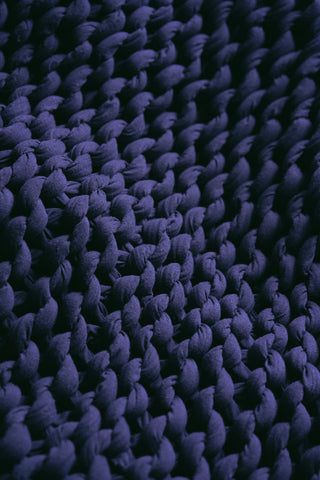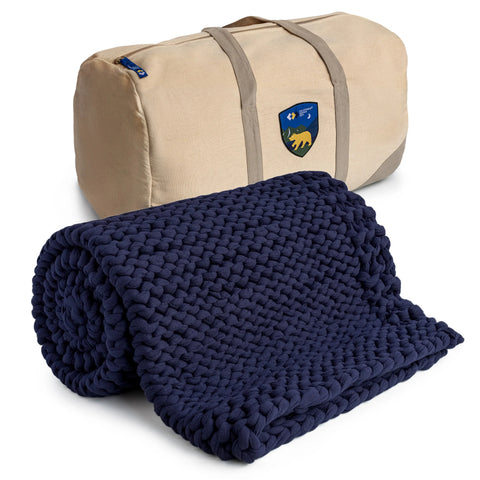
What Are Weighted Blankets Made of?
Diving into sleep essentials, one might wonder, what are weighted blankets made of? Today, we'll peel back the layers of weighted blankets to reveal the materials that make them so special.
From the various fabrics used to the diverse fillings that give them weight, we'll cover it all. We'll also touch on the hand-knitted options and what you can expect from the exterior of these blankets.
Plus, we'll explain how weighted blankets work to provide their calming effects.
What this article covers:
- What Are Weighted Blankets Made of?
- Weighted Blanket Fabrics
- What Are Weighted Blankets Filled With?
- How Weighted Blankets Work
What Are Weighted Blankets Made of?
The weighted blanket benefits are achieved through their special construction. At the heart of their design are two key components: the fabric that forms the outer layer and the fillings that provide weight.
Let's explore these in greater depth.
Weighted Blanket Fabrics
The fabric of a weighted blanket is crucial for comfort, breathability, and durability. Common materials include cotton, polyester, and bamboo. Cotton is prized for its breathability and natural feel, making it ideal for those who prefer a cooler sleeping experience.
These fabrics are selected not only for their tactile qualities but also for their ability to withstand the additional weight. Durability is a key consideration, as the fabric must hold the weighted fillings securely without stretching or tearing.
The choice of fabric can influence the blanket's care requirements, with some materials being more machine-washable than others. Our cotton variety is easy to maintain and machine-friendly!
Hand-Knitted Weighted Composition
Hand-knitted weighted blankets offer a unique approach to the traditional weighted blanket. Unlike their filled counterparts, these blankets achieve their weight through the use of thick, chunky yarn, eliminating the need for internal fillers.

This method provides a distinctive, open weave that allows for excellent airflow, making them a great choice for all seasons.
The tactile sensation of a hand-knitted weighted blanket is unlike any other. The chunky yarn creates a soft, enveloping feel that mimics a gentle hug, promoting relaxation and comfort.
This type of blanket is also visually appealing, adding a dot of texture to your sleeping area.
For those interested in a sustainable and stylish option, our knitted weighted blanket is a perfect choice. Made from cotton, it's not only soft and breathable but also sustainable, certified by leading independent authorities like OEKOTex or GOTS.
Its versatility makes it suitable for all seasons, providing just the right amount of warmth in winter and a breathable comfort in summer.
What Are Weighted Blankets Filled With?
Whats in a weighted blanket, you ask? The comforting weight of weighted blankets comes from a variety of fillings, each selected for its unique properties. Let's explore each option.
Plastic Pellets
Plastic pellets are one of the earliest and most common fillings used in weighted blankets. These pellets are made from polypropylene, a type of plastic.
Based on our observations, plastic pellets are larger and less dense than other fillings, which means they can make the blanket feel bulkier and less smooth.
They also tend to make a slight noise when the blanket is moved around. Not to mention being problematic for the environment.
Glass Beads
These beads are much smaller than plastic pellets, resembling the size and feel of sand grains. This allows for a less bulky blanket. Glass beads are denser than plastic pellets, meaning a blanket filled with glass beads will be thinner.

Steel Beads
Steel beads are another filling option for weighted blankets. These beads are significantly denser than both plastic pellets and glass beads, which means less volume is needed to achieve the same weight, which results in an even thinner blanket.
Due to their metal nature, blankets filled with steel beads can be heavier and more expensive. They are also not as widely available as other fillings.
Sand
Sand is a natural filling option for weighted blankets. Its fine grains allow for a compact and uniform weight distribution.
However, there are some drawbacks to using sand as a filling, specifically with how to wash a weighted blanket filled with sand. It can retain moisture, which may lead to issues with mold or mildew.
Additionally, sand can leak out of the blanket if the fabric is not tightly woven or if the blanket is damaged.
No Fill
Our 12lb weighted blanket takes a different approach by eliminating fillers altogether. Knitted with pure cotton, this blanket offers superior breathability without the need for internal beads or pellets. With this one, there is no wondering which weighted blanket is best for me.
Our research indicates that the open knit design allows for excellent airflow, making it an ideal choice for those who prefer a weighted blanket that is effective during any season.
The absence of fillers means there's no risk of leakage, and the blanket maintains its shape and weight distribution over time. It's easy to maintain and machine washable. This makes it a hygienic and convenient option for daily use.
Available in three sizes and weights (10 lb, 12 lb, and 15 lb), our 12lb weighted blanket is sure to meet your preferences.
How Weighted Blankets Work
Weighted blankets function by applying an even pressure across the body, a sensation known as Deep Pressure Stimulation (DPS). This pressure imitates the feeling of being held, which can have a calming effect on the nervous system.
The theory behind DPS suggests that this pressure helps to reduce cortisol levels (a stress hormone) while increasing serotonin and melatonin levels, neurotransmitters that play roles in relaxation and sleep.
Our findings show that by simulating the feeling of being hugged, weighted blankets promote a sense of security and safety, which can be beneficial for individuals with anxiety, autism, ADHD, and insomnia.
The even distribution of weight encourages the body to shift from its "fight or flight" stress response to a more relaxed "rest and digest" state. This transition not only facilitates a quicker onset of sleep but also contributes to a deeper, more restorative sleep cycle.
Conclusion
There you have it. We've revealed the makeup that makes weighted blankets so beloved. From the cozy fabrics that envelop the exterior to the diverse and thoughtful fillings that give these blankets their comforting heft, we've explored the many facets that contribute to their unique appeal.
Along the way, we've also delved into the hand-knitted options that offer a sustainable and stylish choice for those seeking comfort without compromise. At California Design Den, we offer top-tier, fill-free weighted blankets that are as beneficial for you as they are for the planet.
Visit our online store and let us help you reap the benefits of these therapeutic wonders.
If you want to learn more, why not check out these articles below:
- How to Use a Weighted Blanket
- Weighted Blanket vs Comforter
- Weighted Blanket Benefits
- Do You Put Sheets on An Air Mattress?
- Do You Use a Sheet with a Weighted Blanket?
- How to Get Sheets to Stay on Adjustable Bed
- Should I Buy White Sheets?
- Are Weighted Blankets Good for Arthritis
- Are Weighted Blankets Hot
- Are Weighted Blankets Washable?
- Are Weighted Blankets Worth It
- Can I Put My Weighted Blanket in the Dryer
- Can You Dry a Weighted Blanket?
- Can You Sleep with a Weighted Blanket
- How Do Weighted Blankets Work?



